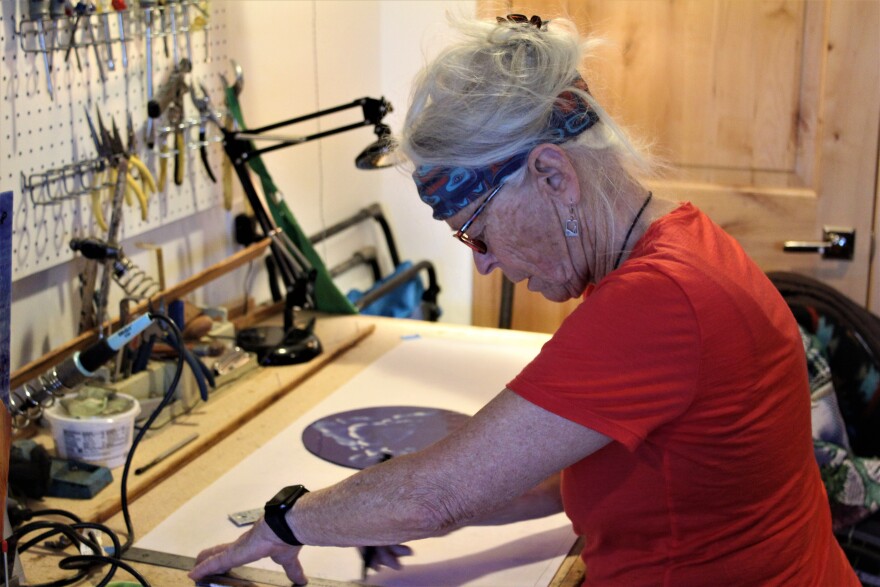It took Sandy and Mary Lynn Munro four years to build their home by hand.
“At that point, it was a shell that we could move into,” Sandy Munro said. “There were no dividing parts between the rooms. We didn't have bathroom doors or anything. It was just a shell of a house after four years of work.”
The house is nestled in the hillside off Brush Creek Road — about 20 minutes from downtown Aspen. The driveway is hidden and easy to miss. It leads to a mixed-material home, surrounded by aspen trees, that feels like it grew straight out of the landscape.
The interior is filled with warm natural light, reflected off the wood walls and floors. Thick beams crisscross overhead. A spiral staircase next to a big kitchen leads to a wraparound walkway and the upstairs bedrooms.

In his new book, “Aspen Unstrung,” Munro writes about building that home in the early 1970s — and many other stories over the decades. The book captures the creation of more than the Munros' home. It also highlights some of the characters who built present-day Aspen.
More than 50 years after construction began, the Munros are still putting the final touches on their home.
In her stained-glass studio next to the kitchen, Mary Lynn Munro gently unfurls sketches of landscapes — “starting out, mountains in spring, moving to canyons,” she said. They are plans for a new backsplash in the kitchen.
This isn’t her first time handling stained glass.
“Look at those hands,” she said. “They're pretty gnarled.”
They’re the hands of “any artist.”

She is not the only artist in the house.
Sandy Munro is best known as a bluegrass musician. He has performed with and managed several bands, including The Flying Dog Bluegrass Band.
He is also an author, most recently of “Aspen Unstrung,” which begins 53 years ago in the air.
He flew in a Navy T-28 aircraft from Pensacola, Florida, to Aspen on a weekend “training” trip. Later that year, in 1969, he left the service.
“The Vietnam War was just really ramping up,” he said. “I went to the Naval Academy in Annapolis, and had I stayed in the service, the next place I would have been going was to a helicopter squadron in Vietnam. And luckily enough, my six years of commitment ended about the same time and I was able to leave the Navy. My father was a naval aviator killed in WWII, and my wife really didn't want me to follow in his footsteps.”
They moved to Aspen during a period of major change for the area. After about 20 years of steady growth in the local ski industry, the development sector in Aspen was beginning to boom.
A movement of self-proclaimed “freaks” were pushing back, trying to seize control of local government and law enforcement.
But the anti-growth movement wasn’t able to stop all growth.
“When we first moved to Aspen, we were finally finishing up the paving of the streets downtown, which was controversial,” he said. “And there's always been a political battle going on between those who would like to develop — you know, the real estate crowd — and those who would like to keep things more like they were. To some degree, that's part of what this whole book is about, in a way. It's a book of stories that tell a story in themselves, when taken all together.”
The early 1970s dominate most of “Aspen Unstrung.” More than half the book chronicles those first years in Aspen, as the Munros buy land and pay someone to build a house.
Sandy Munro described him as “duded up.”
“He was a smooth operator,” he said.
“I don't know that I really trusted him,” Mary Lynn Munro added.
The would-be builder left town with all the Munros' money after setting only the foundation of the house.
The Munros eventually finished building, and then the decades flowed by — along with a colorful cast of characters who played various roles in Aspen community life. They’re all described in vibrant detail in "Aspen Unstrung," including characters such as early computer engineer and successful business executive Nick DeWolf.
Among DeWolf's many activities and projects in Aspen, he designed the perpetually random water fountain in the downtown mall.
“It never once repeats a pattern, forever,” Sandy Munro said. “He had long red hair all the way down his back — long, flowing red hair — and was just a wild character and a great great fun guy.”
“Aspen Unstrung” captures all the random, chaotic ways that people came together to build the Aspen that we know today.
Five decades after the Munros' big move West, more than the streets of downtown Aspen have been paved.
“That's where the runway is,” Sandy Munro said, pointing south toward a line of hills. “And that's where the airplanes all take off, headed in this direction. So, we'll hear them roaring down the runway.”
The view from the cockpit has changed.
Munro ends his book with a reflection on those changes — and a message to folks looking for a life in the mountains.
“There's still a bunch of small mountain towns left,” he said. “Go live in one. Go build your own house in a small mountain town.”
Asked whether Munro, given his background, would be able to live in Aspen today, he said, “No. No way.”
In other words, for the Munros of the 21st century, Aspen isn’t the place to live.






